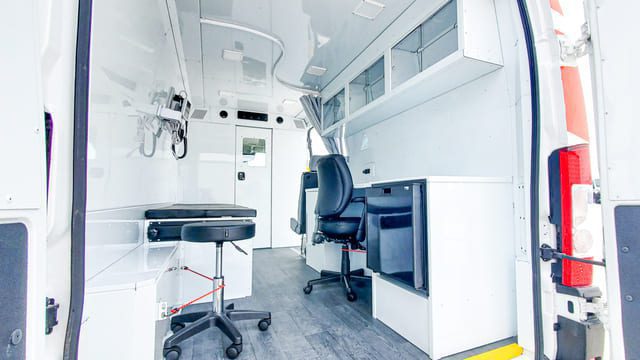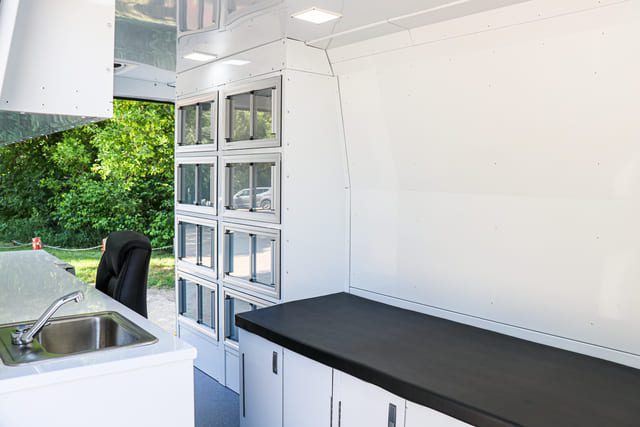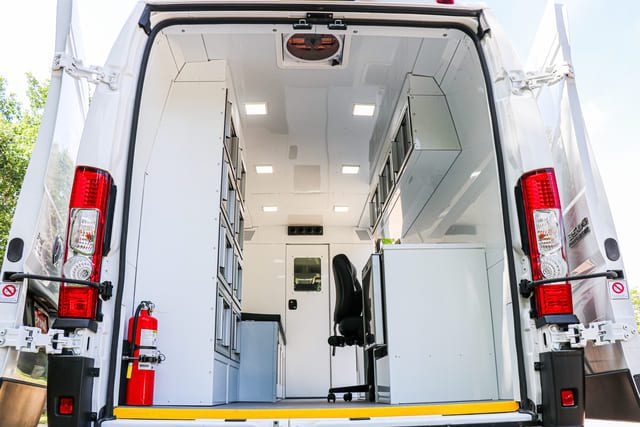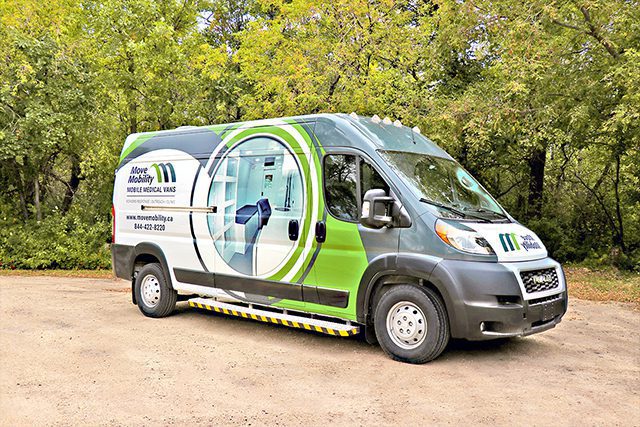Barriers to healthcare are obstacles that make it difficult for people to get the medical attention they need. These barriers range from financial and cultural, to transportation and language barriers. Barriers to healthcare lead to delayed treatment, unnecessary suffering, emotional stress, and health disparities. Fortunately, mobile medical vans are a resolution to these problems.
Our team at MoveMobility works tirelessly to minimize barriers by manufacturing innovative mobile medical vans. Our medical vans support organizations like yours in their mission to improve healthcare accessibility. We’re certified by Transport Canada, are a Ford Qualified Vehicle Modifier, and have Q-Pro certification. We adhere to the highest standards of safety and quality in all of our conversions.
In this article, we’ll start by talking about the different barriers to healthcare that specific people around Canada face. After that, we’ll highlight the 5 ways that mobile medical vans break down barriers to healthcare.
7 barriers to healthcare in Canada (and how mobile medical vans break down these barriers)
Accessing healthcare in Canada is a complex journey with several barriers affecting different people in different regions of the country. Let’s take a closer look at some of the most common barriers to healthcare that people face.
1. Financial barriers
14.5% of Canadians over 12 years of age reported they didn’t have a regular healthcare provider or anyone to talk to when they needed advice for their health. Financial obstacles to healthcare hit vulnerable people hard, especially those with low incomes. While Canada does have universal healthcare, there are gaps in this coverage, including things like dental services.
Sometimes people have to make tough decisions between important medical care and basic needs like food and housing. This can cause them to put off or skip certain types of healthcare. This can make their health get worse over time. It can also end up costing the healthcare system more in the long run.
How can mobile medical vans break down financial barriers?
Mobile medical vans are a great way to break down financial barriers to healthcare. Lots of people around Canada don’t have the finances to travel to a hospital or clinic. Organizations use mobile medical vans to travel directly to communities in need of healthcare. When mobile medical vans are right in a rural, isolated community, people have better access to healthcare.
This also saves money for the healthcare system. Early care prevents health problems from getting worse and costing more money to treat later on.
2. Geographical barriers
The vast size and varied geography of Canada makes it difficult for people in remote or northern regions to access healthcare. Statistics show that in certain places, like Nunavut, there are not enough healthcare providers for the population.
In addition, healthcare in rural and remote areas lags behind compared to urban areas. This lag affects the availability of certain equipment and healthcare professionals. It means that residents will have to travel to urban areas for important medical treatments.
How can mobile medical vans break down geographical barriers?
Getting to a healthcare facility in Canada’s large and sparsely populated areas can be difficult. Mobile medical clinic vans act as a bridge between remote communities and healthcare services. They travel to areas with limited medical access, making it easier for people to get the care they need.
The vans are not only for emergencies. They also provide vaccinations and health check-ups. This proactive approach helps catch health issues early, reducing the severity of diseases.
Indigenous communities often face geographical barriers to healthcare. Mobile medical vans are important in these communities.
3. Language and cultural barriers

Our country’s rich cultural diversity creates healthcare access challenges for some Canadians. When people in different regions speak different languages, it makes it hard for them to talk to doctors. Additionally, indigenous communities experience cultural barriers that limit their access to healthcare services.
How can mobile medical vans break down language and cultural barriers?
Your organization can include healthcare workers who speak different languages in your mobile medical unit. This means anyone, no matter their language, can talk to the healthcare team. It will help them understand medical advice, and feel comfortable during their check-ups.
Mobile medical units often train their staff to respect different cultures. They learn about local customs and traditions to make everyone feel welcome and understood.
Your organization can use mobile medical units to work with community leaders and experts to offer healthcare that fits with the culture and traditions of these communities.
These vans also teach people about health and how to use the healthcare system while respecting different cultures.
4. Wait times
Long wait times for medical services are a significant concern in Canada. In some areas, you might have to wait months to see a specialist or have surgery. By that time, a health concern can progress and get worse when it could have been prevented in the first place.
The waiting time to see a specialist physician in Canada averages around 11.1 weeks between referral from a general practitioner to the time you get treatment. Many people with severe health concerns can’t afford to wait this long.
How can mobile medical vans break down wait time barriers?
Mobile medical units have doctors and medical equipment inside of them. They give people quick help, so they don’t have to wait for an appointment or travel far for healthcare.
Sometimes, it takes a long time to see a specialist in Canada. But mobile medical vans can bring these experts to people in remote communities. That means they don’t have to wait so long to get the care they need.
Mobile medical vans also check people’s health regularly. If they find a problem early, it’s easier to fix. This means they don’t have to wait a long time for specialized treatment.
You typically don’t have to make appointments or wait a long time to visit mobile medical vans. They come directly to the community, so people can get help when they need it.
5. Transportation barriers
For individuals in rural areas, limited public transportation options make it challenging to reach healthcare facilities. Some patients are required to travel long distances to access care, incurring additional costs and time.
For example, remote areas in Northern Manitoba, especially Indigenous communities, are isolated locations that don’t have as many healthcare options compared to Winnipeg, Manitoba.
How can mobile medical vans break down transportation barriers?
Getting to a healthcare facility is tough when people face transportation challenges. Mobile medical vans play a vital role in breaking transportation barriers. They ensure that people can access healthcare services even when transportation is a problem.
In Canada, there are some isolated areas where it’s not easy to travel. Mobile medical vans go to these places so people who can’t easily reach a clinic can still see a doctor. Some of the people who face transportation barriers include:
- Seniors
- People with mobility challenges
- People who can’t afford to travel
6. Mental health stigma
Despite Canada’s commitment to healthcare, the stigma surrounding mental health remains a significant barrier. Statistics reveal that many Canadians hesitate to seek mental health support due to this stigma. In some regions, the lack of mental health services makes the problem even worse.
75% of respondents in a survey of working Canadians revealed that they would be reluctant to disclose mental illness to an employer or co-worker.
How can mobile medical clinic vans break down mental health barriers?
Mobile medical units are not just about physical health; they also play a crucial role in breaking down the stigma associated with mental health issues. They create a safe and accessible space for people to seek help and support for their mental well-being.
Mobile medical vans can be used to offer a private and comfortable environment for individuals to discuss their mental health concerns. This setting allows them to open up without fear of judgment from others, reducing the stigma surrounding mental health.
Your organization can use a mobile medical van with mental health professionals on board. This means people can talk to trained experts who can provide guidance, counseling, and support for mental health challenges.
In addition, your organization can use a mobile medical van to engage with communities. This can help reduce the social stigma associated with mental health.
7. Mobility issues
Everyone should have easy access to healthcare facilities, even if they have trouble moving around. But sometimes making it to a hospital or clinic is too much of a challenge for some. This barrier to healthcare is very frustrating and inconvenient. It discourages people from seeking healthcare altogether.
How can mobile medical vans break down mobility barriers?
Getting to a doctor is tough if you have mobility challenges. Mobile medical clinics help to overcome this barrier. For individuals who can’t leave their homes due to severe mobility issues, mobile medical vans drive directly to them. This means that even those with limited mobility can get essential medical care without having to go anywhere.
What comes next in your journey with MoveMobility?

After reading this article, you have a better idea of some of the different barriers to healthcare that people around the country face.
Now that you learned about the 7 ways that mobile medical vans can break down healthcare barriers, you’re probably wondering what type of mobile medical vans are available.
At MoveMobility, we offer 4 different types of mobile medical vans. Our mobile medical vans can be tailored depending on the specific needs of your organization. Read our article on the costs and possibilities of mobile medical van customization for a closer glimpse.
Lastly, you’re probably also interested in the costs involved with mobile medical vans. Read our article on how much a mobile medical van costs in 2023 to find out.







